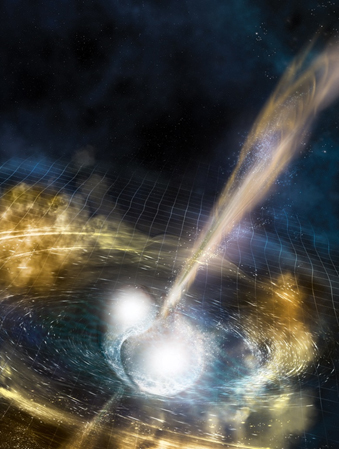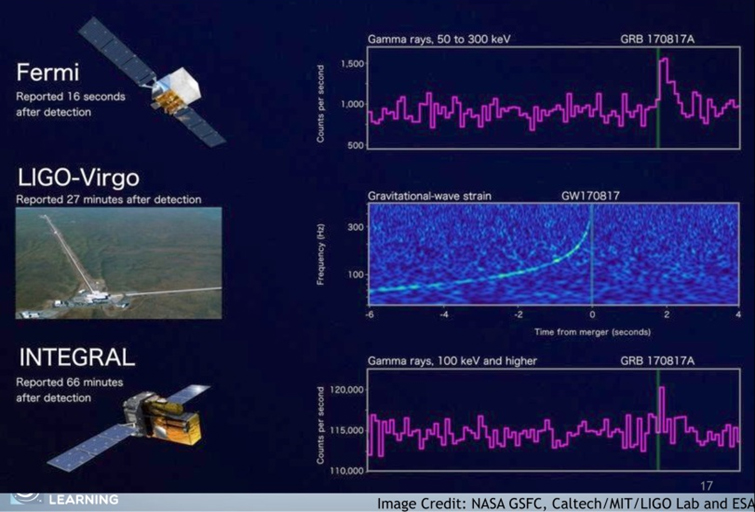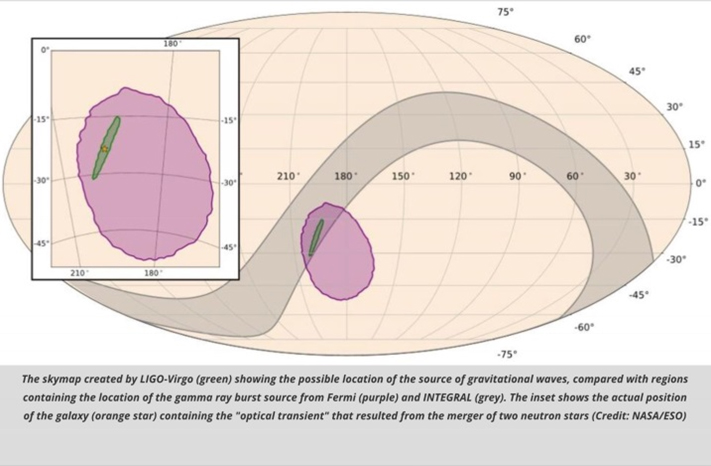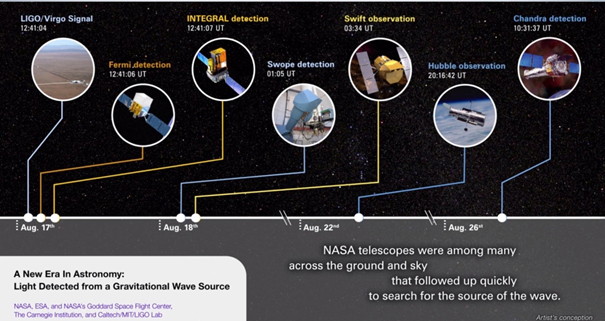The Golden Binary Merger
 Based on the Universe of Learning Science Briefing, “Multi-messenger Astronomy: A New Era in Space Science” by Dr. Ira Thorpe (NASA GSFC), Dr. Colleen Wilson-Hodge (NASA MSFC), and Dr. Lynn Cominsky (Sonoma State University) and “The Universe through Gravitational Waves” by Brian O’Reilly (LIGO Livingston Laboratory). Summarized by Laurie Averill, volunteer Solar System Ambassador, JPL. Unless otherwise noted, all images are courtesy NASA.)
Based on the Universe of Learning Science Briefing, “Multi-messenger Astronomy: A New Era in Space Science” by Dr. Ira Thorpe (NASA GSFC), Dr. Colleen Wilson-Hodge (NASA MSFC), and Dr. Lynn Cominsky (Sonoma State University) and “The Universe through Gravitational Waves” by Brian O’Reilly (LIGO Livingston Laboratory). Summarized by Laurie Averill, volunteer Solar System Ambassador, JPL. Unless otherwise noted, all images are courtesy NASA.)
Ripples in space-time, gravitational waves, traveling 130 million light years at near the speed of light from the merger of a binary neutron star in the galaxy NGC 4993 within the constellation Hydra reached Earth on August 17, 2017, just after 8:41 A.M. (EDT) This infinitesimal stretching of the fabric of space-time was about the diameter of one Hydrogen atom over the average distance between the Earth and the Sun. The Laser Interferometer Gravitational-wave Observatories (LIGO) in Hanford, Washington and Livingston, Louisiana, measured and represented it as a 100 second chirp in which gravitational waves increased in frequency and strength accelerating to beyond 500 cycles per second, the upper limit of the sensors, and then abruptly stopped. Seconds later a short, relatively faint burst of gamma rays was recorded by both NASA’s Fermi Gamma-ray Telescope and the European Space Agency’s INTEGRAL satellite.
 A global cohort of astronomers was alerted and within hours comparisons of the data from Fermi, INTEGRAL, the LIGO’s, and the Virgo detector of the European Gravitational Observatory underground near Pisa, Italy, localized the merger.
A global cohort of astronomers was alerted and within hours comparisons of the data from Fermi, INTEGRAL, the LIGO’s, and the Virgo detector of the European Gravitational Observatory underground near Pisa, Italy, localized the merger.

Space and Earth-based observatories targeted this region and were rewarded with multiple observations of the event in a variety of electromagnetic wavelengths. Swift detected a source of an intense but rapidly decreasing ultra-violet rays. Chandra’s x-ray observatory sensed x-rays from the after-effects of the event nine days after the initial discovery followed quickly by sensing GHz radio emissions. Eleven days after the discovery Karl G. Jansky Very Large Array (VLA) detected a radio source and on September 2 additional observations located the merger as the source and continued collecting data through September 25. Beginning 13 days after the discovery, the Hubble Space Telescope captured images in both optical and the near infrared wavelengths of the event over a period of six days. Twenty-three days after the initial discovery the Spitzer captured the continuing event in infrared showing that heavy elements were produced.
 Initially six ground-based observatories searched for, located, and confirmed the identity of the event as the object that was named as SSS17a or AT 2017gfo. The kilonova initially glowed with a bright, blue light at about magnitude 17, rapidly dimming to red at a rate of about .6 to 1 magnitude per day.
Initially six ground-based observatories searched for, located, and confirmed the identity of the event as the object that was named as SSS17a or AT 2017gfo. The kilonova initially glowed with a bright, blue light at about magnitude 17, rapidly dimming to red at a rate of about .6 to 1 magnitude per day.
(Continued on next page)
